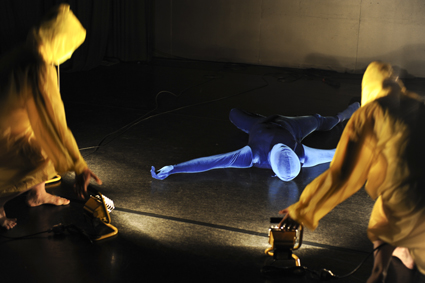 |
PRIME:ORDERLY, Dean Walsh photo Heidrun Löhr |
Presented in two acts, the first performed by Walsh and the second also featuring Natalie Ayton and Kathryn Puie, PRIME:ORDERLY progresses from an exploration of the inky, otherworldly velvet of the bottom of the ocean to the sunlit groan and bubble of a shallow reef.
A thick weave of digital sound swallows me up. After some searching in the blue dimness, I spot a moving body. Then another; then another. The sightings are haunting, like that growing awareness of another intelligence in the room that has presumably been there, and aware of you, for some time.
A body clad from head to toe in blue velvet makes its way into fuller light. The limbs are now straight, now rounded; the body now fluid, now rigid. Its movement verges on looking daft: not human, but intelligent. After some time the soundtrack shifts and the body collapses into a sort of bliss, spreading itself out luxuriantly on the floor and slipping into movement that is no longer halting, but entirely fluid.
I do not recognise the groaning and creaking that accompany the opening of act two as the sounds of the reef until a friend leans over and tells me so. For me the sounds evoke the gentle snores of an enormous, sleeping creature. Upon this reef I lose track of time, escorted onwards by the breath and buoyancy of the diver/dancers.
At first through balloon-like appendages and then into microphones suspended low over the floor, the dancers shape the aural backdrop with their constant, slow breathing. They play, they tumble, float, come to hovering stillness together. They couple up, triple up and repeatedly reach to cradle each others’ heads with their hands.
This wordless play is broken up by conversation when the trio rise to their feet and chat, striding swiftly back and forth across the stage. They crash through three mounds of silver foil that have, until now, sat like small glaciers on the floor. The mounds shatter. I gather that dancers are divers: they talk excitedly about their excursion out to sea and make small talk. The chatter is both unexpected and humorous. Personalities and social nuances emerge for the first time. One at a time, the dancers duck out of the conversation for a quick ‘dive.’ Their exits into muteness, weightlessness and horizontality are clear and sudden.
The performers' conversation doesn’t disturb my sense of being in a state of suspension. On the contrary, it adds to the overall surreality of the piece, which climaxes when all three dancers hit the back wall, causing it to light up as though it were made of gold. Time stands still as the three drift, stare blankly, and perhaps live out in slowed-down verticality what they had lived out on the floor not long before. Conversation is not external to Dean Walsh’s work. It suggests that he understands not only the political importance of human/ocean dialogues, but also their capacity to build aesthetic experience.
Act two closes as the dancers gather up the pieces of silver foil that now litter the stage. This gesture might symbolise human responsibility towards the marine environment—one that is essential, primordial and increasingly at risk.
Form Dance Projects and Riverside: PRIME:ORDERLY, choreographer Dean Walsh, performers Dean Walsh, Natalie Ayton, Kathryn Puie, lighting Mikey Rice, designer sound recorder, mixer Dean Walsh; Riverside Theatres, Parramatta, Sydney, Oct 25-27
RealTime issue #112 Dec-Jan 2012 pg. 28
© Cleo Mees; for permission to reproduce apply to [email protected]








 back
back